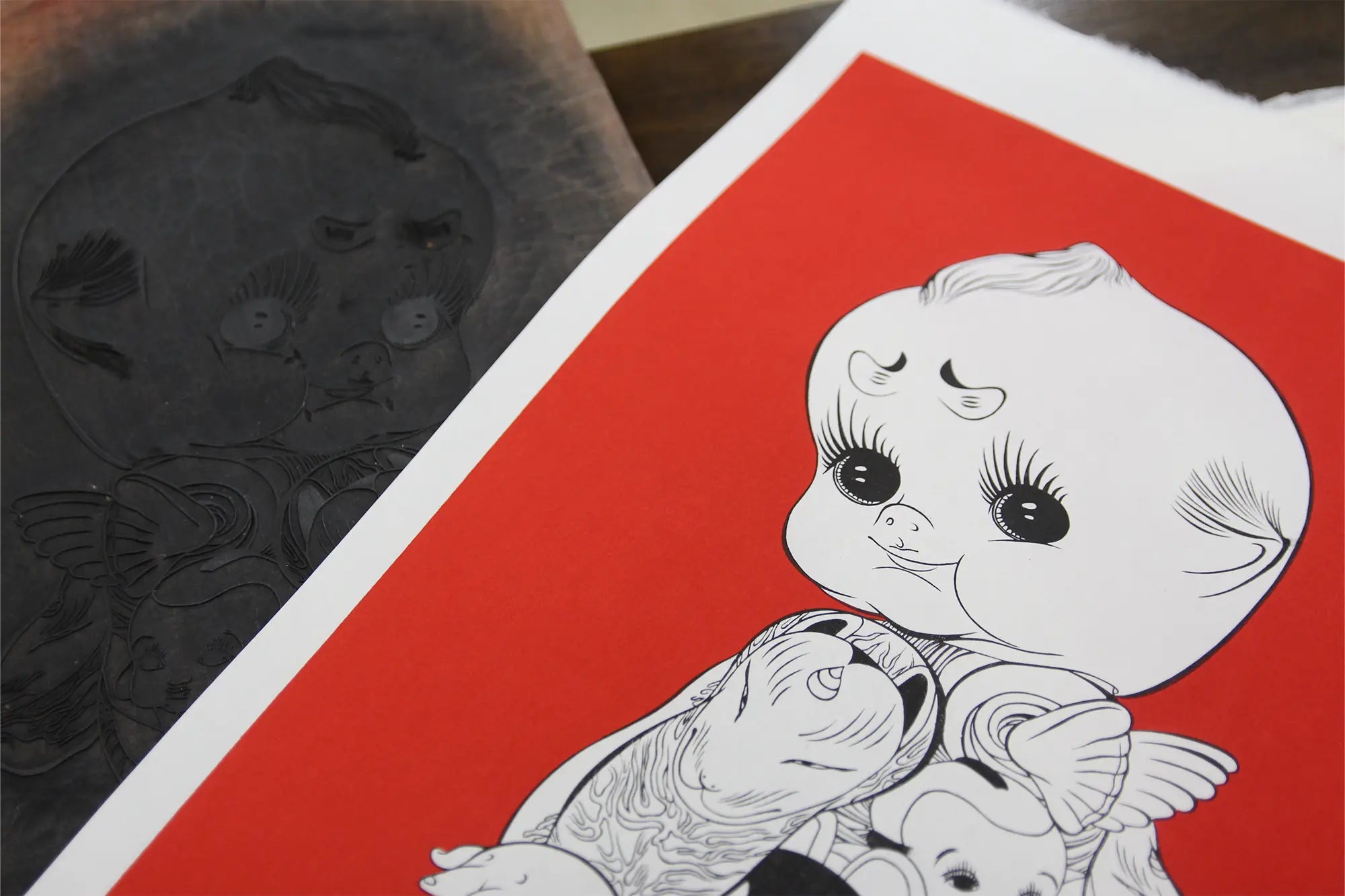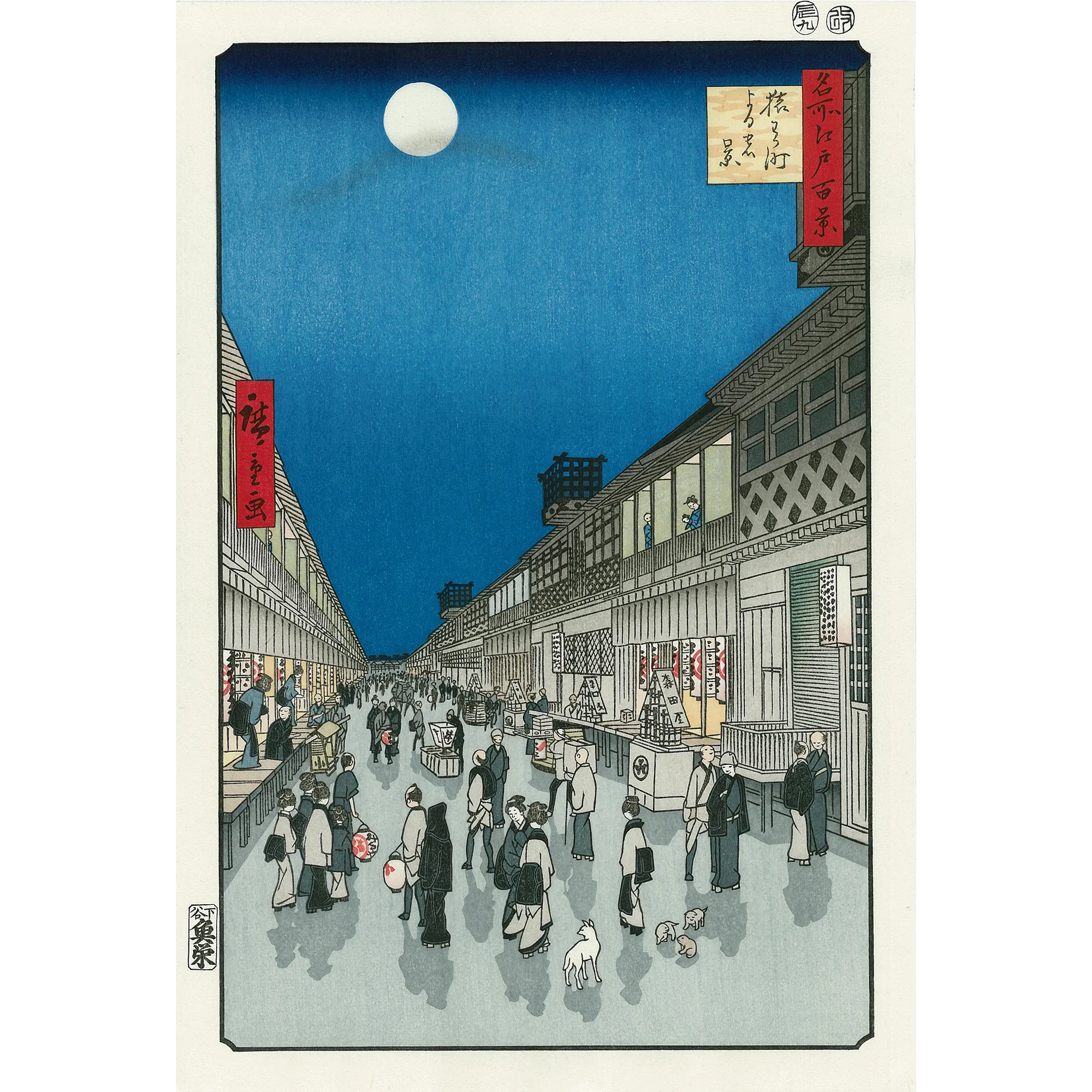

Bridge Ohashi and Atake in Sudden Shower -One Hundred Famous Views of Edo-
“Bridge Ohashi and Atake in Sudden Shower” is part of a series Hiroshige created in his later years entitled “One Hundred Famous Views of Edo'' depicting various landscapes around Edo. It is also well known for being imitated by the Impressionist master Van Gogh.
Ohashi was a bridge that spanned from Hamacho in Nihonbashi to Fukagawa Rokkenbori and was also called “Atake” because the shipyard of the Shogunate's official ship Atake-maru was located here. With a bold composition overlooking the large bridge, this is a masterpiece full of vivid sensations and lyrically depicts the intensity of a sudden summer shower.
↙️Read our article to enjoy the work even more
This print, which Hiroshige created in his later years and can be said to be a culmination of his work, is packed with ingenuity and attention to detail to express a realistic landscape.
Price
Frame & Mat
A: Print only
The print is placed on the paper mat. The internal window of the top of the mat is cut for the image size.
| <For Yourself> | <For Gifts> |
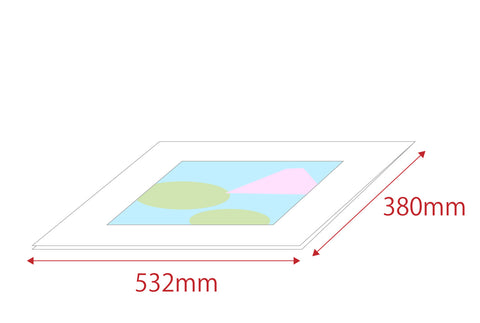 |
 |
B: Framed print
<Ukiyo-e Reproduction> The print is framed with the Adachi original ukiyo-e frame (400 × 555 mm).
<Contemporary Ukiyo-e> The print is framed.
 |
C: Print + matboard
This is a set of a print and a matching matboard. The internal window of a matboard is cut for the image size. The external dimension is fixed for the Adachi original ukiyo-e frame.
 |
|
 |
 |
Frame & Mat
A: Print only
The print is placed on the paper mat. The internal window of the top of the mat is cut for the image size.
| <For Yourself> | <For Gifts> |
 |
 |
B: Framed print
<Ukiyo-e Reproduction> The print is framed with the Adachi original ukiyo-e frame (400 × 555 mm).
<Contemporary Ukiyo-e> The print is framed.
 |
C: Print + matboard
This is a set of a print and a matching matboard. The internal window of a matboard is cut for the image size. The external dimension is fixed for the Adachi original ukiyo-e frame.
 |
|
 |
 |
| Size/Weight | Print Size: 33.8 × 21.7 cm |
| Material | Paper: Echizen Kizuki Hosho Washi made by Living National Treasure, Ichibei Iwano |
| Feature | Type of print: Woodcut Print |
| Notes | This product includes: |
◆Mini Column (1): Secrets of production as seen from the master drawings
In ukiyo-e prints, which are produced through a division of labor between the artist, carver, and printer, the artist does not create the completed drawing in color.
The master drawing (hanshita-e) is what the artist draws using only lines of black ink, and the colored parts are specified later for each color.
If you look at the master drawings, you can clearly see that the way the prints are made and the way the drawings are presented differs depending on the artist.

The master drawing for this print. The parts drawn with lines are limited, and it is difficult to understand the overall image of the finished work just by looking at the drawing.
The master drawing of Hokusai's “The Great Wave off Kanagawa.” Compared to Hiroshige's master drawing, the lines are drawn in more detail, and you can get a rough idea of the finished work just by looking at the master drawing.
The parts that are not drawn with "lines" are expressed as "planes" using woodblocks for each color.
Hiroshige was skilled at creating depth by effectively using planes instead of drawing everything with lines.
The following is a video of some of the processes excerpted from the nearly 20 printing processes for “Bridge Ohashi and Atake in Sudden Shower.”
The bridge in the foreground is combined with the hazy distant view of the opposite bank in the evening shower, creating depth and a lyrical richness. This is a brilliant way to effectively create a sense of space and distance in a two-dimensional print.
◆Mini Column (2): Secrets of the evening shower produced through a two-step printing process
How exactly was the "sudden shower" expressed to become the highlight of this work?

If you look at the woodblocks used for printing the rain, you will see that there are countless lines carved into them. The lines are straight, as if they were drawn with a ruler.
When printed, it looks like there are many layers of rain, but in reality, only two woodblocks are used. Light ink and dark ink are printed, and the angle of the rain is subtly changed to create the effect of a fierce shower.

When you see the lines from the two separate woodblocks used for the rain, you can see that strong rain is expressed by overlapping the lines of rain.

The fineness of the lines is obvious when you compare it to a one yen coin. This requires highly advanced techniques and demonstrates the carver's skill.
Also, the gradations (bokashi) that express the dark clouds in the sky is an important feature that requires skill.

A freehand technique called "atenashi-bokashi." This is not done by using a woodblock on which the shape of a cloud is carved, but by using a brush on a flat board to create gradations in the shape of a cloud.
For a printer who completes around 100 sheets at a time, this "atenashi-bokashi" method of printing clouds of exactly the same shape is an extremely advanced technique that only experienced printers can perform.
| Masterpieces of Ukiyo-e in Rainy Day |
The order for domestic destination(inside of Japan) is shipped by Yamato Transport and international destination (outside of Japan) is shipped by either FedEx or Japan Post's EMS (Express Mail Service).
Domestic Shipping (Inside of Japan)
Yamato Transport Co., Ltd.
You can choose the delivery date and time window. Shipping fee is 700 yen for any destination inside of Japan.
<Free Shipping Service>*Domestic destination only
Free Shipping is available when a total of purchase is over 50,000 yen (for one destination) .
If you would like to choose the delivery date and time window, please fill the column of "Request of Delivery Date". Please note that only the date five business day after your order can be chosen and also this service might be canceled under some circumstances. Please ask us for details.
International Shipping (outside of Japan)
FedEx
Delivery dates are varied depending on the destination countries and areas.
EMS international shipping service may be used for the area which has no or limited FedEx delivery.
Actual shipping fee will be charged for the international delivery. (No free shipping over 50,000 yen purchase is applied for the international shipping.)
*No shipping is available on weekends.
Estimated Fee and delivery time
Area A : East Asia / Southeast Asia
Area B : North America / Indonesia
Area C : Europe / Middle East
Area D : Australia / New Zealand
Area E : South America / Africa / Other Areas
| Area | Delivery time | 1-5 Unframed Prints | One Framed Print |
|---|---|---|---|
| A | 3-6Days | ¥3,600 | 5,300 |
| B | 4-6Days | ¥4,000 | ¥6,000 |
| C | 4-7Days | ¥4,400 | ¥7,000 |
| D | 4-7Days | ¥6,500 | ¥8,000 |
| E | 4-7Days | ¥7,500 | ¥13,500 |
*Please read notes about international shipping
Customs
Please note that the customs may be charged to the consignee during the international shipping process. The customs' manner and fee are various depending on the country where the delivery destination is and the purchaser is required to be responsible for anything regarding customs. The purchaser is considered to agree with being responsible for customs when you place an order.
*FedEx offers the service to charge the custom to a purchaser (not a consignee) after the fee is fixed for the destination country. This service is useful when you would like to ship the item as a gift and do not want the consignee to pay for the custom. Please request us if you would like to use this service.
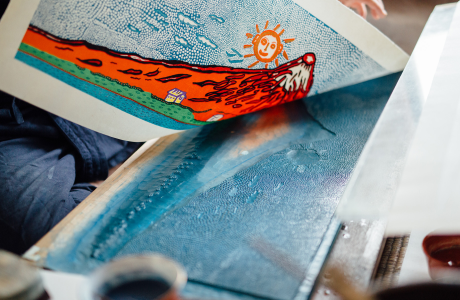
Adachi's Philosophy and Mission
At Adachi Institute of Woodcut Prints, we create attractive works that are in keeping with the times while maintaining the basics of traditional woodcut printing techniques.
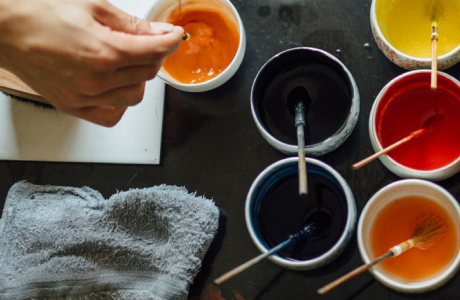
Adachi's Meticulous Quality and Materials
At Adachi Institute of Woodcut Prints, we use carefully selected materials and tools to bring out the original beauty of woodcut prints to the fullest.
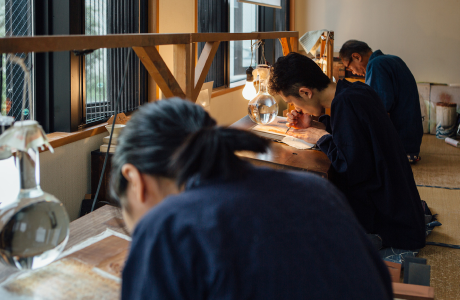
Traditional Techniques and Adachi's Artisans
The production of ukiyo-e, which developed as a commercial printing method, focused on efficiency and profitability. And so, all processes are streamlined and sophisticated. We will introduce the basics of ukiyo-e techniques.

